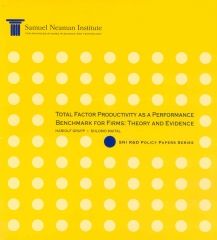We propose using Solow’s macroeconomic approach and the concept of Total Factor Productivity (TFP) as a microeconomic tool for analyzing individual firms. TFP long used in analyzing macroeconomic growth among countries, is a useful strategic performance benchmark for individual firms. TFP calculations permit managers and investors to partition labor productivity growth between two sharplydifferent underlying causes: capital-deepening (higher capital per worker), and exogenous technological change. The TFP benchmark can be computed from readily-available information in financial statements.
The structure of paper is as follows. Section 2 presents a simple version of Solow’s model, suitable for use in individual firms, and provides a numerical example. Section 3 gives detailed total factor productivity calculations for the 20 largest firms in the world. Section 4 provides three case studies of total factor productivity growth, for Intel, YPF (Argentina’s largest energy company) and Merck. The final section summarizes and concludes.












